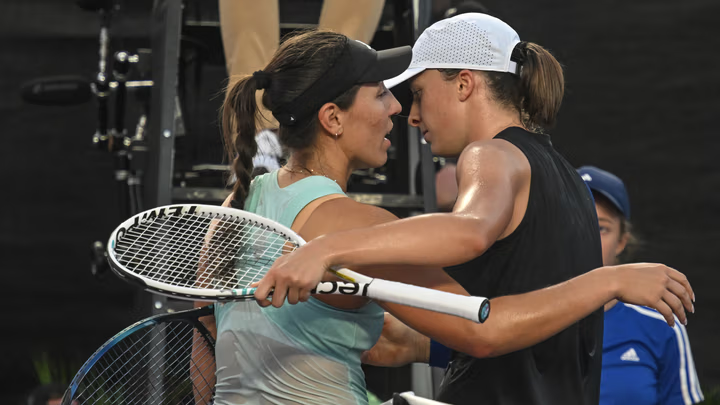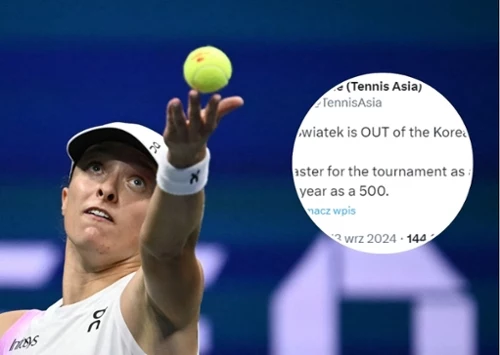Spanish tennis star apologizes for pulling back her eyes with chopsticks in a photo
In a highly controversial incident that has sparked debates around cultural sensitivity and racism in sports, a prominent Spanish tennis star has issued a public apology after a photograph surfaced of her pulling back her eyes using chopsticks—a gesture widely recognized as a racist stereotype of Asian features. The photograph, which was posted on social media and spread rapidly across multiple platforms, has ignited outrage from various communities, especially those of Asian descent, and prompted calls for more significant discussions on the intersection of sport, culture, and respect.
The Incident
The tennis star, who is well-known for her impressive record on the court and a reputation as a fierce competitor, was seen in the photo holding chopsticks near her eyes, pulling them back to mimic a slanted eye shape. The image appeared to have been taken during a light-hearted moment, but the implications of the gesture were anything but trivial. The gesture is steeped in a long history of racial caricatures that have been used to demean and mock people of East Asian descent, dating back to periods of intense anti-Asian sentiment in various Western countries.
The photo was shared on social media, perhaps with the intention of being humorous, but it quickly garnered backlash. Social media users, especially from Asian and Asian-American communities, expressed their anger, frustration, and disappointment, accusing the athlete of engaging in an act that reinforces harmful racial stereotypes. Many pointed out that, while the athlete may not have intended to offend, the gesture was a clear example of how casual racism continues to persist in public life.
The Athlete’s Response
In response to the mounting criticism, the tennis star took to her social media accounts to issue an apology. She expressed regret over her actions, stating that she had not intended to offend anyone and that the gesture was made in ignorance of its racist connotations. The apology read:
“I am deeply sorry for the photo that has been circulating and for the offense it has caused. I now understand that the gesture I made was harmful and rooted in a racist stereotype, and I regret my actions. I am committed to learning more about the impact of my words and actions, and I will work to be more mindful in the future. I apologize to the Asian community and anyone else who has been hurt by this.”
While some accepted her apology, others noted that apologies alone are not sufficient in addressing deep-seated cultural insensitivity. They called for more substantial steps to be taken, such as sensitivity training or public engagements with communities affected by racism.
The Larger Issue of Racism in Sports
This incident has reignited broader discussions about racism in sports and the lack of cultural awareness among athletes and public figures. Sports, as a global phenomenon, bring together people from various ethnicities, backgrounds, and nationalities. However, despite this diversity, incidents of racism—whether intentional or unconscious—continue to emerge across different sports and at various levels of competition.
In tennis, a sport that has traditionally been dominated by players from predominantly Western countries, there have been several notable incidents where racial stereotypes or racially insensitive behavior have come to the forefront. The global nature of the sport, with tournaments spanning different continents and involving players from around the world, necessitates a higher level of cultural awareness and sensitivity. However, it seems that many athletes, whether due to lack of exposure or education, still fall short of meeting these standards.
A key issue is the role that sports organizations, sponsors, and governing bodies play in ensuring that athletes are not only physically trained but also educated on cultural and social issues. The recent apology has led to renewed calls for sports federations, including tennis governing bodies, to implement mandatory cultural sensitivity training for all players. Such training would help athletes better understand the cultural implications of their actions and foster a more inclusive environment in the sports community.
The Role of Social Media
Another significant aspect of this controversy is the role that social media plays in both amplifying and addressing such incidents. In the past, actions like these may have gone unnoticed or unchallenged, but today, the ubiquity of social media means that any public figure’s behavior is immediately scrutinized by a global audience. While this allows for accountability, it also means that mistakes are magnified and can quickly spiral into full-blown controversies.
Social media platforms have increasingly become a battleground for conversations about racism, cultural appropriation, and the responsibilities of public figures. As a result, athletes and celebrities are under constant pressure to present themselves carefully, with even seemingly minor actions being subject to intense scrutiny.
Reactions from the Asian Community
The photo and subsequent apology have elicited strong reactions from Asian advocacy groups, as well as individuals who have experienced the pain of racist stereotypes. Many Asian social media users took to platforms like Twitter and Instagram to express their frustration, explaining how such gestures reinforce long-standing prejudices and perpetuate harmful views about Asian people.
Organizations advocating for Asian representation and against anti-Asian hate also issued statements calling for greater awareness and sensitivity among public figures. A spokesperson for a prominent advocacy group stated, “While we appreciate the apology, we must remember that these types of gestures are not just ‘mistakes’—they are part of a larger pattern of casual racism that many people face daily. Public figures, especially athletes who serve as role models for millions, have a responsibility to educate themselves and lead by example.”
Moving Forward
The incident has sparked a broader conversation about how to address casual racism and cultural insensitivity in public life, especially in the world of sports. Advocates are calling for long-term, systemic changes that go beyond individual apologies. Suggestions include mandatory diversity and cultural sensitivity training for athletes, as well as public forums where players can engage with communities affected by their actions.
Additionally, some have urged tennis organizations and other sports governing bodies to take more proactive steps in promoting inclusivity and addressing racism within their ranks. This includes not only educating athletes but also taking swift disciplinary action in cases of racism, whether intentional or not.
As for the tennis star at the center of the controversy, time will tell how her apology and subsequent actions will be received by the public. While some may be willing to forgive and move on, others are looking for concrete steps that show a commitment to change and a deeper understanding of the harm caused.
Conclusion
The controversy surrounding the Spanish tennis star’s photo serves as a stark reminder of the ongoing challenges of racism and cultural insensitivity in sports. While the apology may help to address the immediate fallout, it is clear that more must be done to educate athletes, foster inclusivity, and ensure that the sports world reflects the diversity and respect that fans and players deserve. The road ahead will require not only individual accountability but also systemic efforts to create a more respectful and culturally aware sporting environment.




